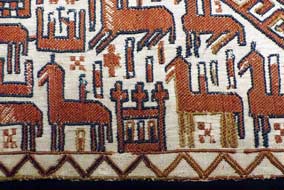Viking and Early Middle Ages Northern Scandinavian Textiles Proven to be made with Hemp
Nowadays most plant textiles used for clothing and household are made of cotton and viscose. Before the 19th century however, plant textiles were mainly made from locally available raw materials; in Scandinavia these were: nettle, hemp and flax. It is generally believed that in Viking and early Middle Ages Scandinavia hemp was used only for coarse textiles (i.e. rope and sailcloth). Here we present an investigation of 10 Scandinavian plant fibre textiles from the Viking and Early Middle Ages, believed to be locally produced. Up till now they were all believed to be made of flax.

The authors show that 4 textiles, including two pieces of the famous Överhogdal Viking wall-hangings are in fact made of hemp (in three cases hemp and flax are mixed). This indicates that hemp was important, not only for coarse but also for fine textile production in Viking and Early Middle Ages in Scandinavia.
The Överhogdal tapestries were found in the vestry of Överhogdal Church by in 1909. The tapestries were brought to Östersund by the artist Paul Jonze in 1910, where the County Governor’s wife Ellen Widén, who was a dominant figure within the regional heritage movement at the time, took charge. The first thing she did was to give the dirty linen a good wash in a bath tub in the cellar. First believed to date from the Middle Ages, radiocarbon dating tests conducted in 1991 proved that the tapestries were made between 1040 -1170 – the late Viking Age.
The four surviving sections of the tapestries have 323 figures of people, and 149 animals; all generally moving to the left. The large animals and the smaller human figures seem to rush to a tree, which might be the sacred ash Yggdrasil, a massive tree central to nine worlds in Norse mythology. The woven pictures have been much debated, some characters believed to have a pagan reference, featuring Odin’s horse Sleipner, while other characters seem to be part of Christian iconography. Some scholars have accordingly suggested that what is shown is the Christianization of the region Härjedalen.
Given the radiocarbon dating of the tapestries, the dominant theory is that the tapestries depict Ragnarök, a series of events foretold to occur in Norse mythology, Research has established that the figures are made of plant dyed wool, which is interwoven with the linen or hemp with a special technique and on a Viking warp weight loom.
The unique tapestries are on display in a specially designed room at Jamtli, the regional museum of Jämtland and Härjedalen in Östersund, Sweden.
See more Viking Tapestries at Pinterest
Viking and Early Middle Ages Northern Scandinavian Textiles Proven to be made with Hemp
By G. Skoglund, M. Nockert & B. Holst
In: Nature, Scientific Reports 3, Article number: 2686 doi:10.1038/srep02686
Received 11 July 2013 Accepted 20 August 2013 Published 18 October 2013 – Open Access
READ MORE:
De gåtfulla Överhogdalsbonaderna – The enigmatic Överhogdal tapestries
By Ulla Oscarsson
96 sidor
Jamtli 2010
ISBN: 978-91-7948-231-2
Language: Swedish and English

